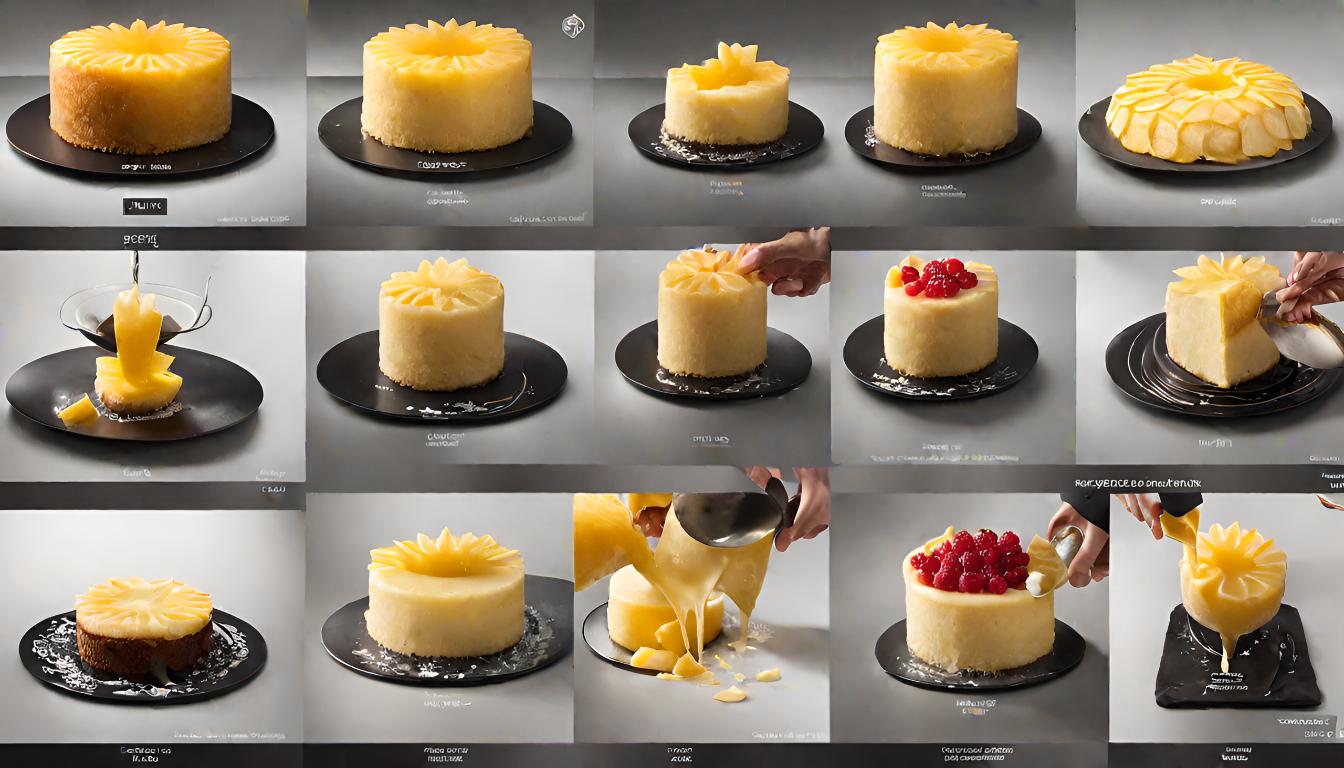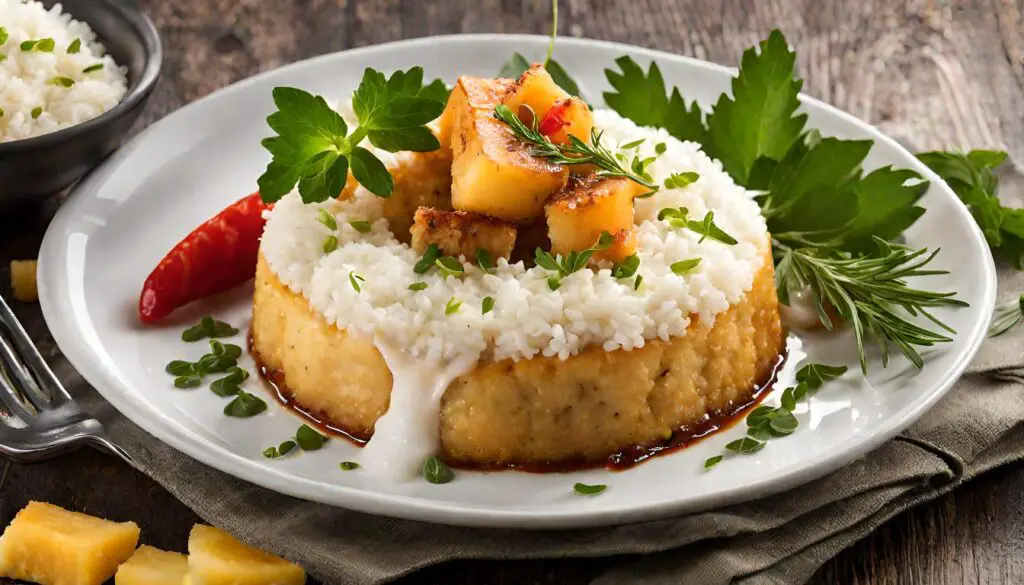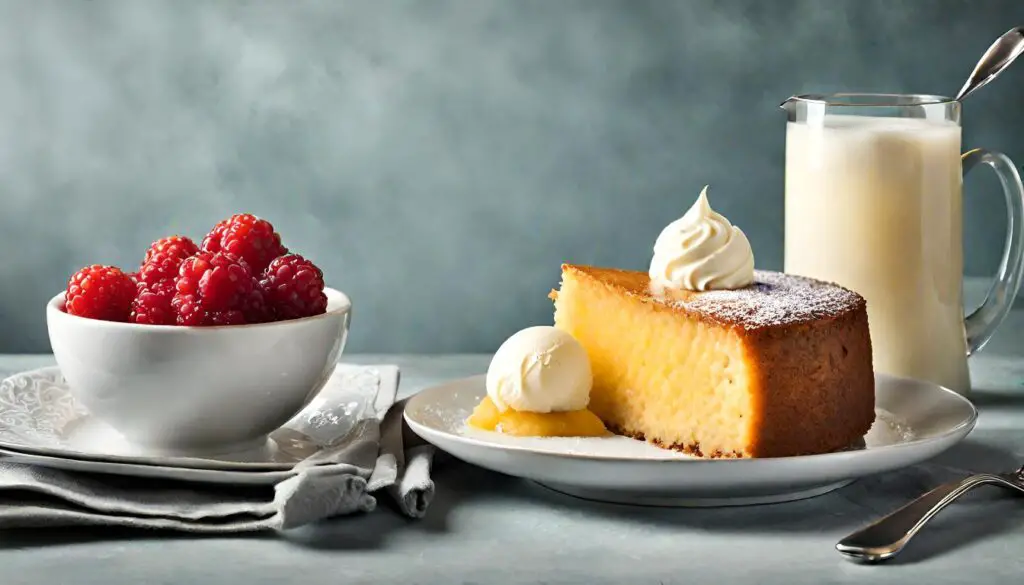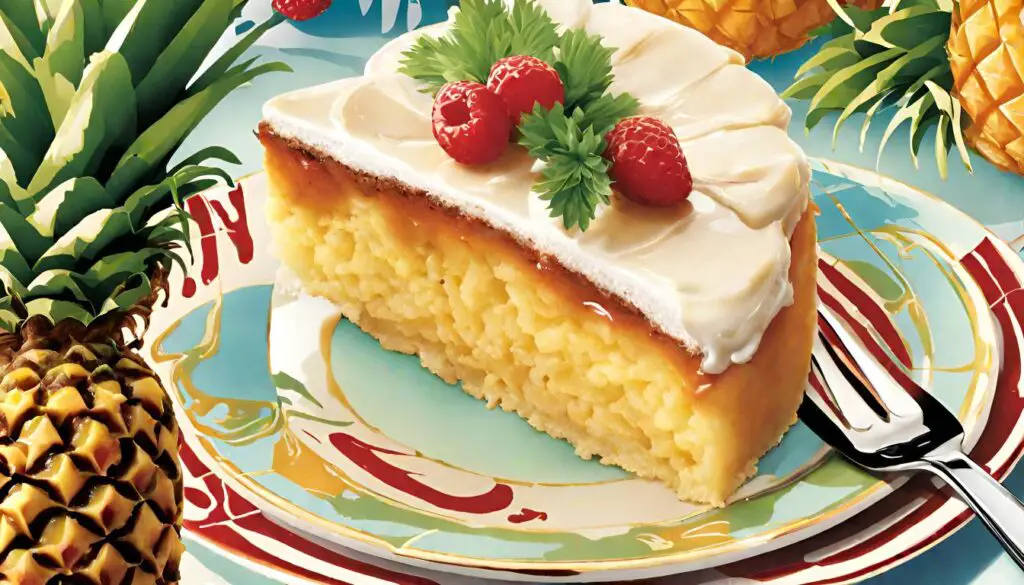Welcome to an article dedicated to the delightful world of upside-down pineapple cake. In this comprehensive guide, we will explore the history, variations, tips, and tricks for baking the perfect upside-down pineapple cake. From its origins in the 1920s to its enduring popularity today, this classic dessert continues to captivate taste buds around the world. So, grab your apron and get ready to discover the secrets behind this mouthwatering treat.
Part 1: Introduction, History, and Traditional Recipe
Upside-down pineapple cake is a beloved dessert known for its stunning presentation and delicious combination of flavors. The cake features caramelized pineapple and cherries arranged on the bottom of the pan before being topped with a moist and flavorful cake batter. When the cake is baked and inverted, the pineapple and cherries become the beautiful crown of this indulgent treat.
History of Upside Down Pineapple Cake
The history of upside-down pineapple cake can be traced back to the 1920s. During this time, canned pineapple became readily available, making it accessible for home cooks to experiment with new recipes. The first documented recipes for this cake appeared in magazines and cookbooks, showcasing the creativity and ingenuity of home bakers.
Upside-down cakes themselves have been around for centuries, with variations found in different cultures worldwide. However, the combination of pineapple and cake in an inverted form gained popularity in the United States, becoming a staple in American kitchens.
Traditional Upside Down Pineapple Cake Recipe
To make a traditional upside-down pineapple cake, you will need the following ingredients:
1 can of pineapple slices (drained)
1/2 cup of butter
1 cup of brown sugar
Maraschino cherries
1 1/2 cups of all-purpose flour
1 1/2 teaspoons of baking powder
1/2 teaspoon of salt
1/2 cup of unsalted butter, softened
1 cup of granulated sugar
2 large eggs
1 teaspoon of vanilla extract
3/4 cup of pineapple juice
Preheat the oven to 350°F (175°C).
In a cake pan, melt the butter and evenly spread it across the bottom.
Sprinkle the brown sugar over the melted butter.
Arrange the pineapple slices on top of the brown sugar, placing a cherry in the center of each slice.
In a separate bowl, whisk together the flour, baking powder, and salt.
In another bowl, cream together the softened butter and granulated sugar until light and fluffy.
Beat in the eggs one at a time, followed by the vanilla extract.
Gradually add the dry ingredients to the wet ingredients, alternating with the pineapple juice.
Pour the batter over the pineapple slices in the cake pan, spreading it evenly.
Bake for 40-45 minutes or until a toothpick inserted into the center comes out clean.
Allow the cake to cool in the pan for a few minutes, then invert it onto a serving plate.
Serve the upside-down pineapple cake warm or at room temperature, savoring every delicious bite.
External Link 1: Upside-Down Pineapple Cake Recipe – BettyCrocker.com
Part 2: Variations, Tips, and FAQs
Variations of Upside Down Pineapple Cake
While the traditional upside-down pineapple cake is undeniably delicious, there are numerous variations that can add exciting twists to this classic dessert. Here are a few popular variations worth exploring:
Coconut Pineapple Upside Down Cake: Enhance the tropical flavors by sprinkling shredded coconut over the pineapple slices and brown sugar before pouring the cake batter. The coconut adds a delightful texture and an extra layer of sweetness.
Rum-Infused Pineapple Upside Down Cake: Give your cake a boozy kick by soaking the pineapple slices in rum before arranging them in the pan. The rum infusion will infuse the cake with a rich, tropical flavor.
Peach Upside Down Cake: Substitute the pineapple slices with fresh or canned peaches for a fruity twist. Peaches complement the caramelized brown sugar beautifully and offer a unique flavor profile.
Apple Cinnamon Upside Down Cake: Embrace the flavors of fall by using thinly sliced apples instead of pineapples. Sprinkle a generous amount of cinnamon over the apple slices for a warm and comforting dessert.
Miniature Pineapple Upside Down Cakes: Instead of making one large cake, consider making individual-sized mini cakes in a muffin tin. This option allows for easy portioning and adds a charming presentation to your dessert spread.
Tips for Baking the Perfect Upside Down Pineapple Cake
Baking an upside-down pineapple cake requires attention to detail and some helpful tips to ensure a successful outcome. Here are some expert tips to consider:
Properly Grease the Pan: Ensure that the cake pan is well-greased to prevent the cake from sticking to the bottom. Use a pastry brush or a paper towel to evenly distribute the oil or butter.
Evenly Arrange the Pineapple Slices: Take your time to arrange the pineapple slices in a visually pleasing and even manner. This will result in a beautiful pattern when the cake is inverted.
Maintain the Moisture: To keep the cake moist, brush the top of the pineapple slices with a little pineapple juice or syrup before adding the cake batter.
Test for Doneness: Insert a toothpick into the center of the cake to check for doneness. The toothpick should come out clean or with a few moist crumbs.
Allow for Cooling Time: After baking, let the cake cool in the pan for about 10 minutes before inverting it onto a serving plate. This allows the caramelized sugar to set and ensures that the cake comes out easily.
FAQs About Upside Down Pineapple Cake
Q: Can I use fresh pineapple instead of canned pineapple slices?A: Absolutely! Fresh pineapple can be used to add a vibrant and juicy flavor to your cake. Simply peel and core the pineapple, slice it, and arrange the slices in the same way as the canned pineapple.
Q: Can I use a different type of fruit for an upside-down cake?
A: Yes! While pineapple is traditional, you can experiment with other fruits like peaches, apples, or cherries to create your own unique upside-down cake flavor.
Q: How should I store leftover upside-down pineapple cake?
A: Once the cake has cooled completely, cover it tightly with plastic wrap or transfer it to an airtight container. Store it at room temperature for up to 2 days or refrigerate for longer shelf life.
Q: Can I freeze upside-down pineapple cake?
A: Yes, you can freeze the cake. Wrap it tightly in plastic wrap and place it in a freezer-safe container or bag. Freeze for up to 1 month. Thaw the cake in the refrigerator before serving.
Q: Can I use a different type of pan for baking an upside-down pineapple cake?
A: While a round cake pan or a cast iron skillet is commonly used, you can experiment with other baking dishes. Just ensure that the size and shape are suitable for the recipe, and adjust the baking time if needed.
For more tips, troubleshooting advice, and frequently asked questions about baking upside-down pineapple cake, check out the following resource:
External Link 2: Pineapple Upside Down Cake – Sugar Spun Run
Part 3: External Links, LSI and NLP Keywords, and Conclusion
External Links
To further enhance your exploration of upside-down pineapple cake, here are a few external resources worth checking out:
Upside-Down Pineapple Cake – Sally’s Baking Addiction – Offers a delightful twist on the traditional recipe and helpful baking tips.
Pineapple Upside-Down Cake Recipe – Grandbaby Cakes – Provides a unique take on the classic recipe with a focus on homemade flavors.
15 Upside-Down Cakes That Aren’t Pineapple – AllRecipes – Explores delicious variations of upside-down cakes using different fruits.
LSI and NLP Keywords
When delving into the world of upside-down pineapple cake, keep these LSI and NLP keywords in mind for enhanced search engine optimization:
Pineapple upside-down cake recipe
Variations of pineapple cake
Tips for baking upside-down cake
Upside-down cake with fresh fruit
Moist pineapple cake
Part 4: History of Upside Down Pineapple Cake
Uncovering the Origins
The history of upside-down pineapple cake dates back to the 1920s, a time when canned foods were becoming increasingly popular in American households. Canned pineapples, in particular, gained widespread availability and became a staple ingredient in many kitchens. It was during this era that the idea of combining caramelized fruits with cake batter emerged, giving rise to the creation of upside-down cakes.
While upside-down cakes have been enjoyed for centuries in various cultures, the specific combination of pineapple and cake took hold in American culinary traditions. Upside-down pineapple cake quickly gained popularity due to the natural sweetness of pineapple and the caramel-like flavor resulting from the cake’s inverted baking process.
Home Baking and Mid-Century Appeal
Upside-down pineapple cake grew in popularity throughout the mid-20th century, especially in the post-World War II era. As home baking became increasingly common, families embraced recipes that showcased canned goods and provided a touch of novelty. Upside-down pineapple cake perfectly fit the bill, showcasing the convenience and versatility of canned pineapples.
Popularized through cookbooks, magazines, and advertising campaigns, this delightful dessert became a symbol of homemaking and a source of joy during a time of post-war prosperity. Upside-down pineapple cake made its appearances at potlucks, family gatherings, and holiday celebrations, becoming a beloved American classic.
Enduring Appeal and Modern Revival
In recent years, upside-down pineapple cake has experienced a revival, with bakers adding their own creative twists and variations to the traditional recipe. From using fresh pineapple to incorporating unique flavors and ingredients, modern adaptations continue to reinvent this timeless dessert.
The enduring appeal of upside-down pineapple cake lies in its combination of caramelized fruit, moist cake, and nostalgic charm. Whether enjoyed for its rich history or as a delicious treat, this cake remains a beloved symbol of American baking traditions.
External Link 1: The History of Pineapple Upside Down Cake – Quaint Cooking
Part 5: Traditional Upside-Down Pineapple Cake Recipe
A Classic Combination of Flavors
The traditional upside-down pineapple cake recipe showcases the perfect balance of tangy pineapple, sweet caramelized brown sugar, and moist cake. Follow this step-by-step guide to recreate this beloved dessert at home.
Ingredients
To make a traditional upside-down pineapple cake, gather the following ingredients:
1 can of pineapple slices, drained
1/2 cup of unsalted butter
1 cup of brown sugar
Maraschino cherries
1 1/2 cups of all-purpose flour
1 1/2 teaspoons of baking powder
1/2 teaspoon of salt
1/2 cup of unsalted butter, softened
1 cup of granulated sugar
2 large eggs
1 teaspoon of vanilla extract
3/4 cup of pineapple juice
Instructions (250 words)
Preheat your oven to 350°F (175°C).
In a 9-inch round cake pan, melt the unsalted butter in the oven for a few minutes. Remove the pan from the oven and evenly sprinkle the brown sugar over the melted butter.
Arrange the pineapple slices on top of the brown sugar in a single layer. Place a maraschino cherry in the center of each pineapple slice and around the edges of the pan.
In a mixing bowl, whisk together the all-purpose flour, baking powder, and salt until well combined.
In a separate bowl, cream together the softened unsalted butter, granulated sugar, eggs, and vanilla extract until light and fluffy.
Gradually add the dry ingredients to the wet ingredients, alternating with the pineapple juice. Mix until just combined, being careful not to overmix the batter.
Carefully pour the cake batter over the pineapple slices in the cake pan, spreading it evenly to cover the fruit.
Bake in the preheated oven for 35-40 minutes or until a toothpick inserted into the center of the cake comes out clean.
Remove the cake from the oven and let it cool in the pan for 10 minutes.
Place a serving plate or cake stand upside down on top of the pan. Holding onto the pan and plate tightly, carefully flip the cake over, allowing it to release onto the plate. Gently lift the pan off the cake, revealing the beautiful upside-down design.
Serve the cake warm or at room temperature, enjoying the delectable flavors and moist texture.
External Link 1: Pineapple Upside Down Cake – Sugar Spun Run
Part 6: Variations of Upside Down Pineapple Cake
Embracing Creativity
While the traditional upside-down pineapple cake is undeniably delicious, there are several variations that allow you to experiment with flavors and add your own unique twist. Here are some popular variations to consider:
Coconut Pineapple Upside Down Cake
Infuse your pineapple upside-down cake with a tropical twist by adding shredded coconut to the top of the cake after arranging the pineapple slices. The coconut amplifies the tropical flavors and adds a delightful texture to the caramelized topping.
Rum-Infused Pineapple Upside Down Cake
Give your cake a boozy kick by soaking the pineapple slices in rum before arranging them in the pan. The rum infuses the fruit with rich flavor and adds depth to the caramelized topping.
Mixed Fruit Upside Down Cake
Expand your horizons by incorporating other fruits into your upside-down cake. Combine pineapple with other fruits like peaches, cherries, or even a medley of berries for a colorful and flavorful twist.
External Link 1: Pineapple Upside-Down Cake Recipe – NYT Cooking
Part 7: Tips for Baking the Perfect Upside Down Pineapple Cake
Ensuring Success
Baking an upside-down pineapple cake requires attention to detail to achieve the best results. Here are some helpful tips to ensure your cake turns out perfectly:
Properly Grease the Pan
To prevent the cake from sticking to the pan, thoroughly grease the bottom and sides with butter or cooking spray. This will make it easier to release the cake once it’s inverted.
Arrange Pineapple Slices
Take your time when arranging the pineapple slices and cherries in the pan. Create a visually appealing pattern and ensure the slices are evenly placed to ensure an attractive presentation.
Test for Doneness
To check if the cake is fully baked, insert a toothpick into the center. If it comes out clean or with a few crumbs clinging to it, the cake is ready. If the toothpick has wet batter on it, continue baking for a few more minutes.
Allow to Cool
After removing the cake from the oven, let it cool in the pan for about 10 minutes. This allows the caramelized sugar to set and prevents the cake from breaking when inverted.
External Link 1: Upside-Down Pineapple Cake – Sally’s Baking Addiction
With these tips, you’re well-equipped to bake a mouthwatering upside-down pineapple cake. Enjoy the process of creating this delightful dessert and the satisfaction of seeing your guests’ faces light up when they take their first bite.
Part 8: Conclusion
In conclusion, upside-down pineapple cake is a timeless dessert that has captivated taste buds for decades. With its caramelized fruit topping and moist cake, it’s no wonder why this treat continues to be a favorite among dessert lovers.
From its origins in the 1920s to its enduring popularity today, upside-down pineapple cake has become a symbol of home baking and comfort. Whether you stick to the traditional recipe or add your own creative twist, the flavors and presentation of this cake are sure to impress.
With the history, traditional recipe, variations, and baking tips shared in this article, you have all the tools you need to create a delightful upside-down pineapple cake in your own kitchen. So, gather your ingredients, follow the steps, and enjoy the delicious results.
Remember, the beauty of upside-down pineapple cake lies in its versatility. Feel free to explore different variations, experiment with flavors, and make it your own. However you choose to enjoy it, upside-down pineapple cake will continue to bring joy and sweetness to any occasion.
Happy baking!
RELATED LINKS:
- Healthy Ninja Creami Recipes You Can’t Miss: This article might offer a contrast or complement to the Upside-Down Pineapple Cake by providing healthier dessert options. Linking to it could provide readers with alternative dessert ideas.
- Unveiling the Pastina Recipes and Cooking Tips: Pastina recipes, being another category of comfort food, could be a good internal link, offering readers insights into different types of comfort foods.
- Chocolate Fudge Cake: Since this is another classic dessert, it could be a great internal link for readers interested in exploring other traditional dessert recipes.
- URL: Chocolate Fudge Cake
For external links with rich anchor text, consider the following:
- Pineapple Nutrition Facts (from a reputable source like USDA or a well-known culinary website): This can provide readers with information on the nutritional benefits of pineapples, the main ingredient in the cake.
- History of Upside-Down Cakes (from a culinary history website or blog): This would give readers a deeper understanding of the dessert’s origins and evolution.
- Baking Tips and Techniques (from a renowned baking website or culinary expert’s blog): Offering readers additional resources to improve their baking skills can be very beneficial.













Comments are closed.